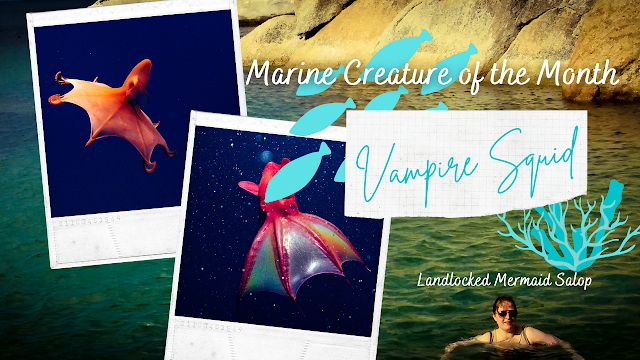Marine Creature of the Month Nov '20
Name: Vampire Squid aka Vampyroteuthis infernalis aka Vampire Squid from Hell
Kingdom: Animalia
Class: Cephalopoda
Conservation Status: Not Evaluated
Location: Deep sea, from 600 to 900m (2-3,00ft), in the OMZ (oxygen minimum zone). Temperate and tropical oceans.
Size: Vampire squid grow to be about 30cm in length, roughly 1 foot. Half of this is made of its gelatinous body, the other half its tentacles.
Appearance: The vampire squid is dark and velvety in colour. Something that separates it from other cephalopods, the exception here being the Blanket Octopus, is the webbing between its tentacle. This gives our cute little MCotM a caped look! Each tentacle is lined with fleshy spines, known as cirri, and they only have suckers on the halves of their tentacles furthest from their bodies.
The vampire squid have large eyes which are blue or red in colour, depending on how the light catches them. These eyes are the largest eyes, proportionally, in the animal kingdom. Upon their mantles, mature vampire squid have two fins which are used as a method of propulsion even though they look more like ears. Like a lot of deep sea creatures, they are entirely covered in phosphorescent organs which produce light used to lure and disorientate prey and predators. They can use these organs to create varied and dazzling light shows, but unlike other squid they do not possess the chromatophores which are used to create camouflage by changing the colour of their skin.
Diet: Detritus - not blood, phew! They also eat larger prey which they lure in with their photophores.
Predators: Large, deep water fish like grenadiers or other deep-diving hunters like whales and sea lions.
Reproductive Cycle: Very little has been confirmed about the vampire squid's reproductive cycle, understandably as they live so deep in the ocean. It is postulated that they lay a few large eggs, rather than spawning millions of tiny ones, and that growth is slow thanks to the nutrient deprived habitat. They take roughly 400 days to hatch and the female is required to brood over them until they do. She does get to pick when she wants to be fertilised though, so that's something. The male's spermatophore detaches and the female hangs onto it until she's good and ready to brood over her eggs for 400 days!
When hatched, the baby vampire squid look exactly like that - miniatures of their mature form, roughly 8mm in length. How cute! There are a few differences though and they transition through two stages before they reach their third and final mature stage. Hatchlings do not possess the webbing between their tentacles and their eyes are much smaller. They do share the same number of fins as mature vampire squid, which their second morphology stage do not. The intermediary stage have two sets of fins. The second pair are near their eyes and slowly shrink as the ear-like fins develop.
Life Span: Unconfirmed. Believed to be 8 years.
Fun Facts:
- The name "Vampire Squid" was inspire by its cloaked appearance rather than its diet.
- They are well adapted to living in oxygen sparse environments. Their blue blood binds and transports oxygen efficiently, their gills have a large surface area, and they have the fun added bonus that living there protects them from apex predators. Apex predators need more oxygen and cannot survive in the OMZ for long.
- When releasing ink, the vampire squid will turn itself inside out. They can also eject a luminescent mucus if agitated.
- Monterey Bay Aquarium, in California, became the first aquarium to display the vampire squid in 2014.
- Juvenile vampire squid don't use their fins for propulsion like their mature counterparts. Instead they use their tentacles for jet propulsion
Do you know any fun facts about the vampire squid? How do you like the new and improved MCotM? Any suggestions for next month's poll? Lemme know, below!
Listening to: Classical Halloween





Comments
Post a Comment